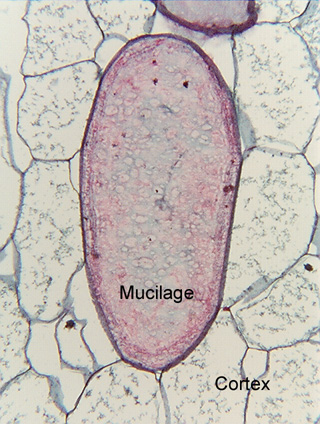 Fig.
9.1-2.
Transverse section of stem of a cactus (Matucana grandiflora, no common
name). Mucilage
cells are common in many cacti and are believed to be adaptive by
helping the cacti to retain water: the slimy mucilage (a carbohydrate, stained
red here) binds to water and prevents it from evaporating. The mucilage is
produced by dictyosomes, packaged into dictyosome vesicles, transported to the
exterior of the protoplast and deposited outside the cell when the vesicles fuse
with the plasma membrane (this is a form of granulocrine
secretion). The mucilage cell -- like virtually all secretory cells
-- is a parenchyma cell, and even though it has only a thin primary wall, the
wall is compact enough to prevent the mucilage from leaking out into the
intercellular spaces. As the mucilage accumulates, the protoplast must shrink
– there is only a limited amount of volume enclosed by the cell wall.
Ultimately, the protoplast shrinks to virtually nothing and dies, then the
entire volume becomes filled with mucilage. This type of mucilage cell is fairly
common in many plant families (southerners will be familiar with okra [Hibiscus
esculentus] which is very slimy if not cooked properly), and has been
studied by electron microscopy (see Botanical Gazette 141: 374-378
(1980)).
Fig.
9.1-2.
Transverse section of stem of a cactus (Matucana grandiflora, no common
name). Mucilage
cells are common in many cacti and are believed to be adaptive by
helping the cacti to retain water: the slimy mucilage (a carbohydrate, stained
red here) binds to water and prevents it from evaporating. The mucilage is
produced by dictyosomes, packaged into dictyosome vesicles, transported to the
exterior of the protoplast and deposited outside the cell when the vesicles fuse
with the plasma membrane (this is a form of granulocrine
secretion). The mucilage cell -- like virtually all secretory cells
-- is a parenchyma cell, and even though it has only a thin primary wall, the
wall is compact enough to prevent the mucilage from leaking out into the
intercellular spaces. As the mucilage accumulates, the protoplast must shrink
– there is only a limited amount of volume enclosed by the cell wall.
Ultimately, the protoplast shrinks to virtually nothing and dies, then the
entire volume becomes filled with mucilage. This type of mucilage cell is fairly
common in many plant families (southerners will be familiar with okra [Hibiscus
esculentus] which is very slimy if not cooked properly), and has been
studied by electron microscopy (see Botanical Gazette 141: 374-378
(1980)).